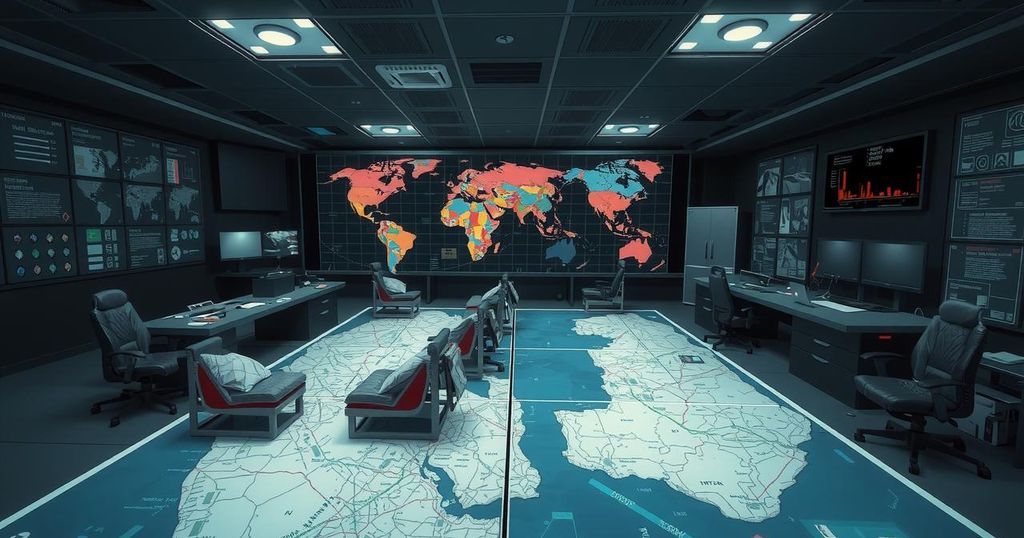US CENTCOM leaders engaged with SDF commanders in northeast Syria to discuss the threat posed by Islamic State fighters amid ongoing conflict. Camps housing IS detainees were visited, revealing growing concerns about future militant generations. Continued fighting between the SDF and Turkish-backed forces has escalated tensions, prompting calls for US intervention to secure a ceasefire. The situation remains complex with significant regional implications, involving external pressures and humanitarian concerns.
On Thursday, US Central Command (CENTCOM) announced that General Michael Erik Kurilla and his team met with the leadership of the Syrian Democratic Forces (SDF) in northeast Syria. The visit aimed to address the ongoing threat posed by the Islamic State (IS) and the overall situation in the region, particularly as fighting continues amid rising tensions.
The CENTCOM statement revealed that General Kurilla toured several camps housing IS fighters and their families, notably the al-Hol and al-Roj camps, which collectively shelter around 40,000 individuals. It emphasized that without international repatriation and rehabilitation efforts, these camps are likely to create a future generation of ISIS militants, as approximately 9,000 detainees remain under SDF custody, forming a significant “ISIS Army” in detention.
In addition to his visit to Syria, General Kurilla’s itinerary included stops in Bahrain, Saudi Arabia, the USS Harry S. Truman in the Red Sea, Egypt, Lebanon, Israel, Iraq, and Jordan during an eight-day mission. The United States is particularly concerned about the presence of numerous IS fighters in northeast Syria, especially in light of ongoing clashes between the Kurdish-led SDF and the Turkish-backed Syrian National Army (SNA) that began in December.
SDF Commander Mazloum Abdi acknowledged the importance of the US in facilitating a ceasefire between conflicting parties. He stated, “We reaffirm the importance of strengthening partnerships and the critical role of the U.S. in achieving a permanent ceasefire in northeast Syria and ensuring security and stability across the entire country.”
The fighting between the SDF and SNA has resulted in significant casualties since mid-December, especially around the city of Manbij, and ongoing clashes persist near the Tishreen Dam. According to the UK-based Syrian Observatory for Human Rights, around 400 individuals have been killed in this period.
Turkey continues to apply pressure regarding the situation in northeast Syria, as it perceives the area as a refuge for the Kurdistan Workers Party (PKK), an entity it has been engaged in conflict with for over forty years. Concurrently, high-level discussions occurred between Commander Abdi and former President of the Kurdistan Regional Government of Iraq, Masoud Barzani, regarding the future of intra-Kurdish relations and current developments in Syria.
Furthermore, SDF leadership has initiated meetings with Syria’s transitional government led by Ahmed al-Sharaa, focusing on the potential integration of the SDF and the northeast into a consolidated Syrian government and defense structure.
The current dynamics in northeast Syria involve multiple factions, including the Kurdish-led Syrian Democratic Forces and Turkish-backed militia forces. The US military presence is aimed at countering the resurgence of the Islamic State and maintaining stability in the region. Recent escalations in conflict have exacerbated the humanitarian situation, particularly in camps housing former IS members and their families. The ongoing discussions among Kurdish leaders and the Syrian government reflect complex political maneuvers amid heightened tensions, often influenced by external pressures, such as Turkey’s interests in the region.
The meeting between US CENTCOM leaders and the SDF amidst ongoing conflict in northeast Syria highlights the critical role the US plays in mitigating violence and fostering stabilization. As fighting continues to claim lives, addressing the humanitarian crisis within IS detention camps remains imperative. Efforts to reinforce partnerships and navigate intricate political relations within Syria will be essential in achieving a lasting resolution to the tensions in the region.
Original Source: www.newarab.com






